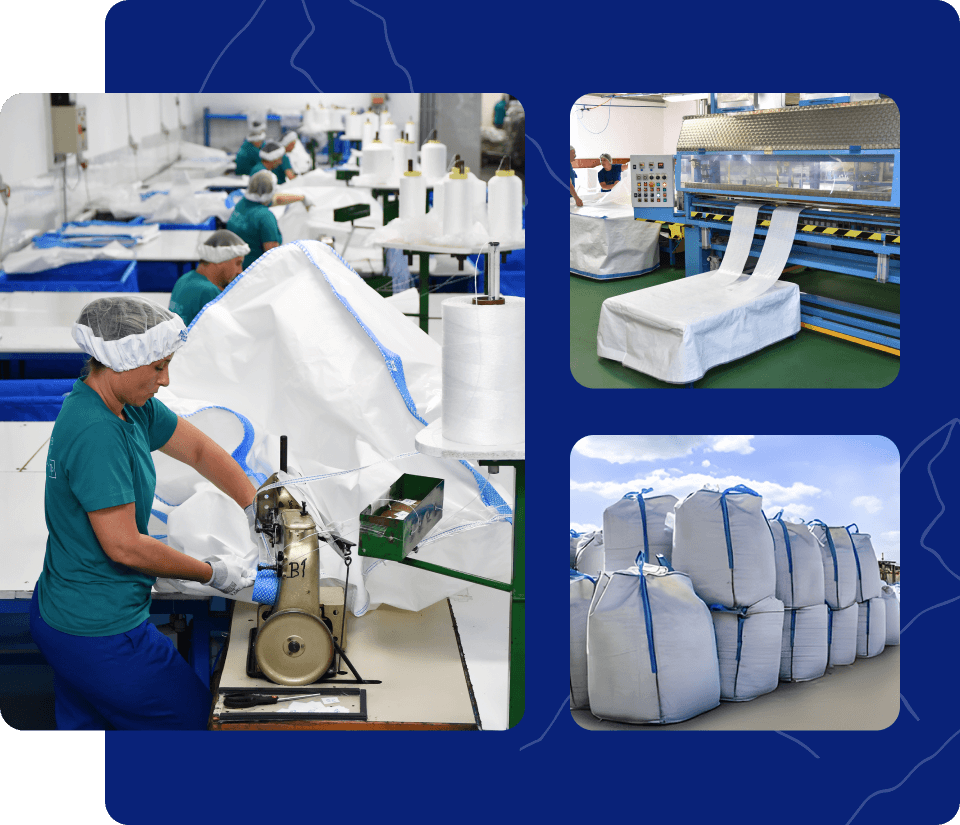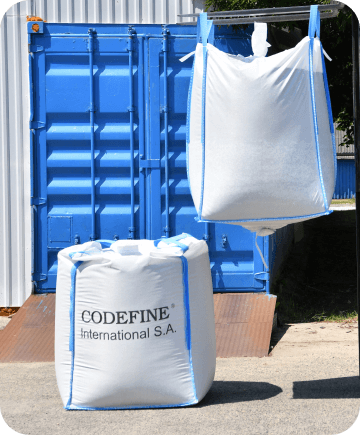Home » Posts Page » Blog » Products and Materials » The Essential Buying Checklist for Choosing the Right FIBC Bulk Bags

FIBC bulk bags, also known as super sacks or jumbo bags, are industrial containers designed for storing and transporting dry, flowable products in quantities typically ranging from 500 to 4,000 pounds. These versatile packaging solutions have revolutionized material handling across industries due to their strength-to-weight ratio and cost efficiency.
The International Electrotechnical Commission (IEC) classifies FIBC bags into four primary types based on their electrostatic properties:
Type A bags are standard containers with no special electrostatic protection, making them suitable for non-flammable or non-explosive materials in environments where static discharge risks are minimal. Type B bags are constructed from woven polypropylene fabric with no anti-static properties but have a lower breakdown voltage; while offering some improvement over Type A, they still lack sufficient protection for hazardous environments. Type C bags are anti-static containers manufactured with conductive threads interwoven throughout the fabric in a grid pattern. When properly grounded, these bags safely dissipate static charges, making them appropriate for flammable environments and combustible powders. Type D bags offer anti-static protection through static dissipative threads in the fabric. Unlike Type C, they don’t require grounding and protect against static build-up through their dissipative properties.
Understanding your product characteristics and handling environment is crucial when selecting the appropriate FIBC type. Factors such as product flammability, moisture sensitivity, and filling/discharge methods will significantly influence which type provides optimal safety and functionality.
When sourcing FIBC bulk bags, verifying proper certifications ensures your packaging meets industry standards and regulatory requirements. Key certifications to look for include UN Certification, which is critical for transporting hazardous materials. These certifications (e.g., UN 13H3/Y) indicate the bag has been tested and approved for specific dangerous goods, with codes providing information about construction, material, and safe handling limits. Safe Working Load (SWL) Certification confirms the maximum load capacity testing conducted by manufacturers, with standard safety factors typically ranging from 5:1 to 6:1, meaning bags are tested to withstand five to six times their rated capacity.
Additionally, ISO 21898:2004 sets international standards that specify requirements for construction, performance, and testing methods for FIBCs, ensuring consistency in quality and safety. For food industry applications, look for FDA compliance, EU 10/2011 regulations, or BRC packaging certification to ensure materials are safe for food contact. Pharmaceutical or other contamination-sensitive applications may require clean room certification regarding manufacturing environment cleanliness.
Always request documentation of these certifications from suppliers and verify testing dates, as certifications require periodic renewal to maintain validity.
Properly matching FIBC load capacities to your specific requirements is crucial for operational safety and efficiency. Safe Working Load (SWL) represents the maximum weight the bag can safely carry under normal conditions. Standard capacities range from 500kg to 2,000kg (approximately 1,100 to 4,400 lbs), but custom capacities are available to meet specific needs.
To determine the appropriate size and load capacity, calculate the volume of product to be contained, factor in product density (heavier products may require stronger bags), consider handling conditions (mechanical lifting, stacking requirements), and account for environmental factors (moisture absorption may increase weight). The bag’s dimensions (height, width, depth) should align with your filling equipment specifications, pallet dimensions for efficient storage, transportation container dimensions to maximize space utilization, and product flow characteristics during filling and discharge.
FIBC bags offer extensive customization possibilities to address specialized requirements across different industries and applications. Filling and discharge systems can be tailored to specific needs, with top options including open top, duffle top, or spout top designs with various diameters.
Structural customizations address specific performance requirements. Baffled designs prevent bulging and maintain a cubic shape for stable stacking. Conical bottoms improve discharge characteristics for difficult-flowing materials. Some applications benefit from compartmentalized designs for multiple product storage or ventilated construction for products requiring airflow.
Industry-specific features address unique requirements, such as conductive grounding tabs for hazardous materials, aseptic construction for pharmaceutical applications, metal detectable components for food processing, or insulated designs for temperature-sensitive products. Work with manufacturers willing to develop prototypes and conduct field testing to ensure customizations meet your specific operational requirements before full-scale implementation.
Sustainability considerations are increasingly important in industrial packaging decisions. When evaluating single-use versus multi-trip options, consider that single-use bags typically utilize lighter-weight fabrics (160-180 GSM), while multi-trip designs incorporate heavier fabrics (200+ GSM), reinforced lift points, and stronger seams. UN-certified multi-trip bags must maintain certification through their intended usage cycle, and cost analysis should include total trips expected, as 3-5 trips typically justify a multi-trip investment.
Recyclability is another important consideration. Standard polypropylene FIBCs are recyclable in appropriate facilities, though coated or laminated bags may have limited recyclability. Some manufacturers offer recycling programs for end-of-life bags, and the market now includes options with up to 30% recycled content for enhanced sustainability.
Environmental impact can be reduced through several approaches. Optimized dimensions reduce transportation emissions, proper sizing minimizes material usage, and lightweight designs balance durability with resource conservation. When possible, local sourcing reduces the carbon footprint associated with transportation.
End-of-life planning should be part of your procurement strategy. Establish protocols for the collection of used bags, partner with recycling facilities capable of processing industrial fabrics, consider closed-loop systems where manufacturers reclaim materials, and evaluate upcycling possibilities for damaged bags. Documenting your environmental considerations demonstrates corporate responsibility and may provide competitive advantages in environmentally conscious markets.
A comprehensive approach to FIBC procurement goes beyond unit price to consider the total cost of ownership and value-based selection criteria. Initial purchase considerations include volume pricing thresholds, with significant price breaks typically beginning at 500+ units. Lead time premiums for rush orders versus planned procurement, payment terms impact on cash flow, and import duties and logistics costs for international sourcing all affect the true cost of procurement.
Quality-related cost factors should be carefully evaluated. Higher-grade materials may increase initial cost but reduce failure rates and associated expenses. Premium construction reduces product loss and contamination risks, enhanced features may improve operational efficiency, and certified products reduce compliance liability risks.
Operational cost implications extend beyond the purchase price. Handling efficiency through faster filling and discharge reduces labor costs, storage efficiency with stable stacking reduces warehouse footprint requirements, transport optimization through consistent dimensions maximizes container utilization, and improved product protection reduces damage claims and waste.
Codefine has established itself as an industry leader in industrial packaging solutions with specialized expertise in FIBC bulk bag manufacturing and customization. Our approach combines technical excellence with customer-focused service. Codefine maintains stringent quality control systems throughout production, utilizing state-of-the-art manufacturing facilities with regular third-party auditing and certification. Our multi-point inspection protocols ensure every bag meets or exceeds specified requirements.
Our engineering team provides comprehensive consultation on material selection, design optimization, and application-specific customizations. With decades of combined experience across diverse industries, we deliver solutions that address unique operational challenges. Codefine offers extensive customization options, from specialized liner systems to complex printing requirements. Our design team works closely with clients to develop tailored solutions for specific product characteristics, handling systems, and regulatory environments.
By partnering with Codefine for your FIBC requirements, you gain access to comprehensive packaging expertise and reliable products engineered for your specific application needs.
